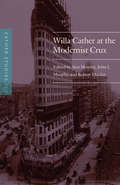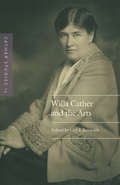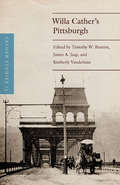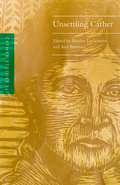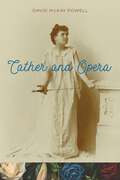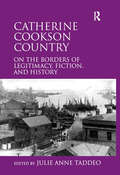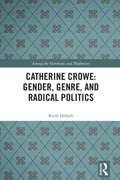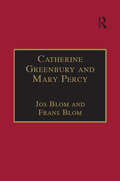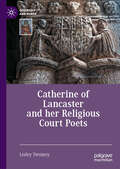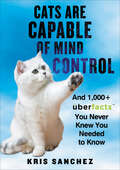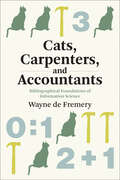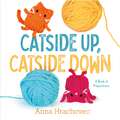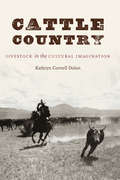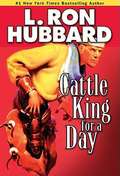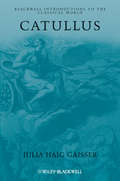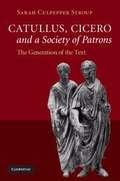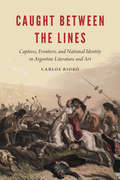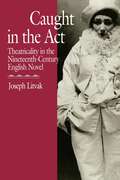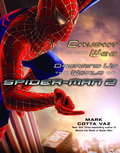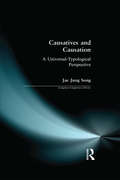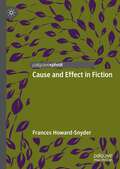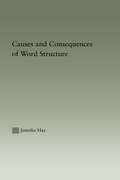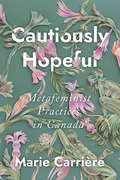- Table View
- List View
Cather Studies, Volume 11: Willa Cather at the Modernist Crux (Cather Studies)
by Robert Thacker John J. Murphy Cather Studies Ann MoseleyWilla Cather at the Modernist Crux examines Willa Cather’s position in time, in aesthetics, and in the world. Born a Victorian in 1873, Cather made herself a modernist through the poems, stories, and novels she wrote and published into the twentieth century. Beginning with a prologue locating Cather’s position, this volume of Cather Studies offers three sets of related essays. The first section takes up Cather’s beginnings with her late nineteenth-century cultural influences. The second section explores a range of discernible direct connections with contemporary artists (Howard Pyle, Frederic Remington, and Ernest Blumenschein) and others who figured in the making of her texts. The third section focuses on The Song of the Lark, a novel that confirms Cather’s shift westward and elaborates her emergent modernism. An epilogue by the editors of The Selected Letters of Willa Cather addresses how the recent availability of these letters has transformed Cather studies. Altogether, these essays detail Cather’s shaping of the world of the early twentieth century and later into a singular modernism born of both inherited and newer cultural traditions.
Cather Studies, Volume 12: Willa Cather and the Arts (Cather Studies)
by Cather StudiesOver the five decades of her writing career Willa Cather responded to, and entered into dialogue with, shifts in the terrain of American life. These cultural encounters informed her work as much as the historical past in which much of her writing is based. Cather was a multifaceted cultural critic, immersing herself in the arts, broadly defined: theater and opera, art, narrative, craft production. Willa Cather and the Arts shows that Cather repeatedly engaged with multiple forms of art, and that even when writing about the past she was often addressing contemporary questions. The essays in this volume are informed by new modes of contextualization, including the increasingly popular view of Cather as a pivotal or transitional figure working between and across very different cultural periods and by the recent publication of Cather&’s correspondence. The collection begins by exploring the ways Cather encountered and represented high and low cultures, including Cather&’s use of &“racialized vernacular&” in Sapphira and the Slave Girl. The next set of essays demonstrates how historical research, often focusing on local features in Cather&’s fiction, contributes to our understanding of American culture, from musicological sources to the cultural development of Pittsburgh. The final trio of essays highlights current Cather scholarship, including a food studies approach to O Pioneers! and an examination of Cather&’s use of ancient philosophy in The Professor&’s House. Together the essays reassess Cather&’s lifelong encounter with, and interpretation and reimagining of, the arts.
Cather Studies, Volume 13: Willa Cather's Pittsburgh (Cather Studies)
by Cather StudiesWilla Cather wrote about the places she knew, including Nebraska, New Mexico, New York, and Virginia. Often forgotten among these essential locations has been Pittsburgh. During the ten years Pittsburgh was her home (1896–1906), Cather worked as an editor, journalist, teacher, and freelance writer. She mixed with all sorts of people and formed friendships both ephemeral and lasting. She published extensively—and not just profiles and reviews but also a collection of poetry, April Twilights, and more than thirty short stories, including several collected in The Troll Garden that are now considered masterpieces: &“A Death in the Desert,&” &“The Sculptor&’s Funeral,&” &“A Wagner Matinee,&” and &“Paul&’s Case.&” During extended working vacations through 1916, she finished four novels in Pittsburgh.Cather Studies, Volume 13 explores the myriad ways that these crucial years in Pittsburgh shaped Cather&’s writing career and the artistic, professional, and personal connections she made there. With contributions from fourteen well-known Cather scholars, this collection of essays recognizes the importance Pittsburgh played in Cather&’s life and work and deepens our appreciation of how her art examines and elucidates the human experience.
Cather Studies, Volume 14: Unsettling Cather (Cather Studies)
by Cather StudiesAmerican author Willa Cather was born and spent her first nine years in the Shenandoah Valley of Virginia. Here, as an observant daughter of a privileged white family, Cather first encountered differences and dislocations that remained lively, productive, and sometimes deeply troubling sites of tension and energy throughout her writing life. The essays in Cather Studies, Volume 14 seek to unsettle prevailing assumptions about Cather&’s work as she moved from Virginia to Nebraska to Pittsburgh to New York City to New Mexico and farther west, and to Grand Manan Island. The essays range from examinations of how race shapes and misshapes Cather&’s final novel, Sapphira and the Slave Girl, to challenges to criticisms of her 1935 novel, Lucy Gayheart. Contributors also frame fresh discussions of Cather&’s literary influences and cultural engagements in the first decade of her career as a novelist through the lens of sex and gender and examine Cather&’s engagements with region as a geopolitical, sociolinguistic, and literary site. Together, the essays offer compelling ways of seeing and situating Cather&’s texts—both unsettling and advancing Cather scholarship.
Cather and Opera
by David McKay PowellThroughout her fiction, Willa Cather mentioned forty-seven operas. References to opera appear in all but three of her twelve novels and in roughly half of her short stories. Despite a dearth of musical education, Cather produced astute writing about the genre beginning in her earliest criticism and continuing throughout her career. She counted opera stars among her close friends, and according to Edith Lewis, her companion throughout adulthood, the two women frequently visited the theater, even in the early days, when purchasing tickets to attend performances proved a financial sacrifice. Melding cultural history with thoughtful readings of her works and discussions of opera’s complex place in turn-of-the-century America, David McKay Powell’s Cather and Opera offers the first book-length study of what drew the writer so powerfully and repeatedly to the art form. With close attention to Cather’s fiction and criticism, Powell posits that at the heart of both her work and the operatic corpus dwells an innate tension between high artistic ideals and popular acceptance, often figured as a clash between compositional integrity and raw, personal emotion. Considering her connection to opera in both historical and intertextual terms, Cather and Opera investigates what operatic references mean in Cather’s writing, along with what the opera represented to her throughout her life.
Catherine Cookson Country: On the Borders of Legitimacy, Fiction, and History
by Julie Anne TaddeoBritain's most widely read author of the late twentieth century, Catherine Cookson published more than 100 books, including The Fifteen Streets, The Black Velvet Gown, and Katie Mulhollond. Set in England's industrial northeast, her novels depict the social, economic, and emotional hardships of that area. In the first essay collection devoted to Cookson, the contributors examine what Cookson's memoirs and historical fiction mean to readers, including how her fans contribute to her position in the cultural imaginary; constructions of gender, class, and English and Irish identity in her work; the importance of place in her novels; Cookson's place in the heritage industry; and television adaptations of Cookson's works. Cookson's work tackled topics that were still taboo in the early post-World War II era, such as domestic abuse, rape, and incest. This collection places Cookson in historical context and shows how skillful she was at pushing generic boundaries.
Catherine Crowe: Gender, Genre, and Radical Politics (Among the Victorians and Modernists)
by Ruth HeholtThis is the first full-length study of the popular Victorian writer Catherine Crowe (1790-1872). Crowe is increasingly being recognised as an important and influential figure in the literary and Spiritualist circles of the nineteenth century. This monograph offers a reassessment of her major works, arguing that her writing is prescient. Best known today for her collection of "real" ghost tales The Night Side of Nature: or of Ghosts and Ghost Seers, Crowe also wrote five popular novels as well as numerous short stories and essays. Innovative and sometimes original in their use of genre, her works cover the Newgate genre, help to initiate detective fiction, include elements of the social problem novels of the 1840s, and point the way to the sensation novels of the 1860s. Politically radical in many ways Crowe was vocal about women’s oppression by men, social inequality, poverty, slavery, and animal rights. This volume aims to restore an author who was "[o]nce as famous as Dickens or Thackeray" (Wilson 1986, v) to her proper place in the scholarly discussion of Victorian literature.
Catherine Greenbury and Mary Percy: Printed Writings 1500–1640: Series 1, Part Four, Volume 2 (The Early Modern Englishwoman: A Facsimile Library of Essential Works & Printed Writings, 1500-1640: Series I, Part Four #Vol. 2)
by Jos BlomThis volume includes two early seventeenth-century translations of Roman Catholic books by English recusant nuns - Catherine Greenbury (a Franciscan) and Mary Percy (a Benedictine). To practise their faith on the continent both these women fled Elizabethan England where Roman Catholic practice had been outlawed under pain of severe penalty (even death). Catherine Greenbury was born at York into a wealthy upper middle-class family but left England after the death of her husband, shortly after the birth of her daughter in or around 1616. After establishing herself in Brussels in a convent dedicated to St Elizabeth, she became its first elected 'Mother' in 1626. During her early years here she translated the work included in this volume - François van den Broecke's biography in Dutch of the saintly Queen Elizabeth of Portugal. A comparison of Greenbury's version with the Dutch text shows not only that the translation is very competent and faithful, but also that she takes the editorial freedom to improve the text. Lady Mary Percy, daughter of Thomas Percy the seventh Earl of Northumberland, left England for Flanders and in 1598 she founded a Benedictine convent in Brussels especially for Englishwomen. Here Mary Percy translated a 1598 French edition of Breve compendio, by the Italian Jesuit Achille Gagliardi with his student Isabella Berinzaga, a mystical handbook which guides the reader through a series of elaborately defined stages striving towards 'deiformitie' - a state in which the soul is 'united unto the will of God'.
Catherine of Lancaster and her Religious Court Poets (Queenship and Power)
by Lesley TwomeyThis book offers an integrated study of the English princess and Castilian queen Catherine of Lancaster (1373–1418), drawing on available archival, architectural, and poetic sources in England and Spain. Catherine’s mother, Queen of Castile in exile, and father, the powerful military commander John of Gaunt, raised her to take the Castilian throne. This volume connects Catherine’s early life, providing insights into those who promoted her cause from birth as Princess of Castile, and her later life as Princess of Asturias, then Queen-consort, and finally Dowager and Co-regent of Castile. Her influence on the Castilian court’s poetic circles has not previously been connected to her English heritage. Poetry written about her and influenced by her was compiled into a songbook presented to her son, Juan II. The book brings new understanding of the role an Englishwoman played in Trastámara Castile’s turbulent history.
Cats Are Capable of Mind Control: And 1,000+ UberFacts You Never Knew You Needed to Know
by Kris SanchezFrom the creator of the popular Twitter sensation UberFacts comes this fun compilation quiz book, packed with entertaining infographics and surprising factoids, for fans of Schott’s Miscellany, What If? and Ripley’s Believe It or Not.Providing "the most unimportant things you’ll never need to know”—fun and surprising facts, statistics, and infographics on diverse subjects, from art and science to history and popular culture—UberFacts has become one of the most widely followed and successful accounts on Twitter, followed by nearly 12 million people.Based on the popular social media phenomenon and culled from an exhaustive variety of sources—science journals, books, media, and literary magazines—Cats are Capable of Mind Control is a fascinating collection of shocking, delightful, educational, and informative facts and figures that are entertaining, topical, and sometimes downright bizarre (the safest place to suffer sudden cardiac arrest in the U.S. is a casino).Did you know:The Pentagon was constructed so that no point in the building is more than a ten-minute walk from any other point?Vultures’ stomach acid is so corrosive they can digest anthrax?Farmers in India use Coca-Cola and Pepsi as cheap and effective pesticides?Discover all this and much, much more in this treasure trove of trivia for the social media age.
Cats, Carpenters, and Accountants: Bibliographical Foundations of Information Science (History and Foundations of Information Science)
by Wayne de FremeryAn expansive case for bibliography as infrastructure in information science.Cats, Carpenters, and Accountants argues that bibliography serves a foundational role within information science as infrastructure, and like all infrastructures, it needs and deserves attention. Wayne de Fremery&’s thoughtful provocation positions bibliography as a means to serve the many ends pursued by information scientists. He explains that bibliographic practices, such as enumeration and description, lie at the heart of knowledge practices and cultural endeavors, but these kinds of infrastructures are difficult to see. In this book, he reveals them and the ways that they formulate information and meaning, artificial intelligence, and human knowledge.Drawing on scholarship from areas as diverse as data science, machine learning, Korean poetry, and the history of bibliography, de Fremery makes the case for understanding bibliography as a generative mode of accounting for what has been received as data, what he calls &“carpentry-accounting.&” Referencing a well-known debate in the Anglo-American bibliographical tradition that features a willful cat, he suggests that bibliography and bibliographers are intentionally marginal figures who, paradoxically, perform foundational work in the service of the diverse disciplinary ends that formulate, however loosely, information science as a field. When we attend to the marginal but essential work of accounting for what humankind has fashioned as recorded knowledge, it becomes easier to consider the ways that human accounts can serve and, sometimes, injure us. Relevant to scholars and students from the sciences to the humanities, Cats, Carpenters, and Accountants is a highly original argument for bibliography as a marginal but foundationally powerful force shaping information science as a field and the ways that we know.
Catside Up, Catside Down: A Book of Prepositions
by Anna HrachovecFilled with whimsical knitted cats, Anna Hrachovec's debut picture book Catside Up, Catside Down blends the silliness of cats with an early introduction to prepositions. Catside up, catside down.Cat on a turntable, spinning around!Under a piano, over the moon, swept high and away by a cat-shaped balloon. A collection of cozy, knitted cats find themselves in all sorts of funny positions in this rhyming picture book that introduces prepositions like over, under, between, beside, and many more!
Cattle Country: Livestock in the Cultural Imagination (At Table)
by Kathryn Cornell DolanAs beef and cattle production progressed in nineteenth-century America, the cow emerged as the nation&’s representative food animal and earned a culturally prominent role in the literature of the day. In Cattle Country Kathryn Cornell Dolan examines the role cattle played in narratives throughout the century to show how the struggles within U.S. food culture mapped onto society&’s broader struggles with colonization, environmentalism, U.S. identity, ethnicity, and industrialization. Dolan examines diverse texts from Native American, African American, Mexican American, and white authors that showcase the zeitgeist of anxiety surrounding U.S. identity as cattle gradually became an industrialized food source, altering the country&’s culture while exacting a high cost to humans, animals, and the land. From Henry David Thoreau&’s descriptions of indigenous cuisines as a challenge to the rising monoculture, to Washington Irving&’s travel narratives that foreshadow cattle replacing American bison in the West, to María Amparo Ruiz de Burton&’s use of cattle to connect race and imperialism in her work, authors&’ preoccupations with cattle underscored their concern for resource depletion, habitat destruction, and the wasteful overproduction of a single breed of livestock.Cattle Country offers a window into the ways authors worked to negotiate the consequences of the development of this food culture and, by excavating the history of U.S. settler colonialism through the figure of cattle, sheds new ecocritical light on nineteenth-century literature.
Cattle King for a Day
by L. Ron HubbardWrangle with the outlaws in the wild, wild west. After receiving word of his grandfather's premature death, Chinook Shannon rides long and hard from Arizona to reach Bull Butte, Montana. When three local road agents fail to stop him from entering town, he arrives only to be told by the local banker that the family's Slash S cattle ranch--the largest in the territory--will be foreclosed in just twenty-four hours.Chinook soon discovers that it may be far tougher than he thought to discover who killed his grandfather and who is trying to take his ranch away, as he faces forgery, sabotage and murder! ALSO INCLUDES THE WESTERN STORY "COME AND GET IT""...Here is nonstop action with a Mark Twain twist." --True West * An International Book Awards Finalist
Catullan Provocations: Lyric Poetry and the Drama of Position (Classics and Contemporary Thought #1)
by William FitzgeraldRestoring to Catullus a provocative power that familiarity has tended to dim, this book argues that Catullus challenges us to think about the nature of lyric in new ways. Fitzgerald shows how Catullus's poetry reflects the conditions of its own consumption as it explores the terms and possibilities of the poet's license. Reading the poetry in relation to the drama of position played out between poet, poem, and reader, the author produces a fresh interpretation of almost all of Catullus's oeuvre. Running through the book is an analysis of the ideological stakes behind the construction of the author Catullus in twentieth-century scholarship and of the agenda governing the interpreter's position in relation to Catullus.
Catullus (Blackwell Introductions to the Classical World #36)
by Julia Haig GaisserCatullus is one of the liveliest and most appealing Roman poets. His emotion, charm, and apparent spontaneity resonate with readers as strongly today as in antiquity. This sophisticated literary and historical introduction brings Catullus to life for the modern reader and presents his poetry in all its variety of emotions, subjects, and styles. Places Catullus in a social, historical, and literary context Examines Catallus's style and subjects, and provides a literary introduction to his major themes of love, social life, and politics Discusses the reception of the poems by translators and interpreters
Catullus, Cicero, and a Society of Patrons
by Sarah Culpepper StroupThis is a study of the emergence, development, and florescence of a distinctly 'late Republican' socio-textual culture as recorded in the writings of this period's two most influential authors, Catullus and Cicero. It reveals a multi-faceted textual - rather than more traditionally-defined 'literary' - world that both defines the intellectual life of the late Republic, and lays the foundations for those authors of the Principate and Empire who identified this period as their literary source and inspiration. By first questioning, and then rejecting, the traditional polarisation of Catullus and Cicero, and by broadening the scope of late Republican socio-literary studies to include intersections of language, social practice, and textual materiality, this book presents a fresh picture of both the socio-textual world of the late Republic and the primary authors through whom this world would gain renown.
Caught between the Lines: Captives, Frontiers, and National Identity in Argentine Literature and Art (New Hispanisms)
by Carlos RiobóCaught between the Lines examines how the figure of the captive and the notion of borders have been used in Argentine literature and painting to reflect competing notions of national identity from the nineteenth to the twenty-first centuries. Challenging the conventional approach to the nineteenth-century trope of “civilization versus barbary,” which was intended to criticize the social and ethnic divisions within Argentina in order to create a homogenous society, Carlos Riobó traces the various versions of colonial captivity legends. He argues convincingly that the historical conditions of the colonial period created an ethnic hybridity—a mestizo or culturally mixed identity—that went against the state compulsion for a racially pure identity. This mestizaje was signified not only in Argentina’s literature but also in its art, and Riobó thus analyzes colonial paintings as well as texts.Caught between the Lines focuses on borders and mestizaje (both biological and cultural) as they relate to captives: specifically, how captives have been used to create a national image of Argentina that relies on a logic of separation to justify concepts of national purity and to deny transculturation.
Caught in the Act: Theatricality in the Nineteenth-Century English Novel
by Joseph LitvakLitvak demonstrates that private experience in the novels of Austen, Charlotte Brontë, Eliot, and James is a rigorous enactment of a public script that constructs normative gender and class identities. He suggests that the theatricality which pervades these novels enforces social norms while introducing opportunities for novelists to resist them. This approach encourages a rethinking of the genre and its cultural contexts in all their instability and ambivalence.
Caught in the Web: Dreaming up the World of Spider-Man 2
by Mark Cotta VazTheSpider-Man 2Dream Machine—from original idea to final cut— unmasking the creative genius at work in the blockbuster movie The epic adventure of one of the greatest superheroes of all time explodes on the silver screen as never before. Now, in this captivating journey behind the scenes and into the imagination, fans can discover how the myth and magic became real inSpider-Man 2, as they plunge deeper into Spider-Man’s world to meet the characters, explore the environments, and follow the storyline in a stunning visual journey. Packed with hundreds of amazing production illustrations, prepared by many of the most talented illustrators in Hollywood,Caught in the Webfeatures • Original sketches, artwork, and doodles that became the inspirations for characters, sets, and computer–generated imagery • Climactic scenes from the movie as they first appeared in conceptual art • Design work used to develop costumes and visual effects—as well as blueprints and architectural drafts used in the construction of both physical and virtual environments • Unique insights into the genesis of Doc Ock—revealing how he evolved from his comic-book origins • An intimate behind-the-scenes look at the full creative process forSpider-Man 2 Enter the amazing realm where dreams come true and discover how the epic adventure was created as you immerse yourself in the action and atmosphere ofSpider-Man 2, from the first rough sketches to the final on-screen adventure. From the Trade Paperback edition.
Causatives and Causation: A Universal -typological perspective (Longman Linguistics Library)
by Jae Jung SongCausatives and Causation is the first comprehensive study of causative constructions found in the world's languages. This important new research, based on a data base of more than 600 languages, not only investigates fully the richness and variety of causative types, but also presents an alternative perspective to the traditional typological approach. The new typology enables a better understanding of how the human mind cognizes causation and how this is reflected in language. Causatives and Causation is also an important attempt to integrate language typology with diachrony by constructing a diachronic model of causative affixes on the basis of this new typology. Drawing on the theoretical insight of Role and Reference Grammar, this book provides a case study of the causative constructions in Korean, providing additional support for both the proposed new typology and the diachronic model. It also examines the pragmatic foundations of causatives, an important but previously unexplored area of study.
Cause and Effect Reading Comprehension Book Reading Level 3.5-5.0
by EdupressAn effective tool for instruction, practice, and evaluation of student understanding. It includes ideas on how to introduce cause and effect to students, as well as activities to help teach and practice the concept.
Cause and Effect in Fiction
by Frances Howard-SnyderThis book explores and defends George Saunders’ causal thesis that successful stories are those that establish causation well. The book includes an in-depth discussion of causation’s role in several different key craft elements of fiction writing and examines different theories of causation and their implications for causation in fiction. Other discussions include the role of causation in building suspense, character and causation, causation in dialogue and connections between fiction and counterfactuals (or hypotheticals). The book also considers a number of objections to the causal thesis and offers a reply.
Causes and Consequences of Word Structure (Outstanding Dissertations in Linguistics)
by Jennifer HayFirst published in 2003. Routledge is an imprint of Taylor & Francis, an informa company.
Cautiously Hopeful: Metafeminist Practices in Canada
by Marie CarrièreIf feminism has always been characterized by its divisions, it is metafeminism, a term coined by Lori Saint-Martin, that defines and embraces that disorder. As a carefully devised reading practice, metafeminism understands contemporary feminist literature and theory as both recalling and extending the tropes and politics of the past. In Cautiously Hopeful Marie Carrière brings together seemingly disparate writing by Anglo-Canadian, Indigenous, and Québécois women authors under the banner of metafeminism.Familiarizing readers with major streams of feminist thought, including intersectionality, affect theory, and care ethics, Carrière shows how literary works by such authors as Dionne Brand, Nicole Brossard, Naomi Fontaine, Larissa Lai, Tracey Lindberg, and Rachel Zolf, among others, tackle the entanglement of gender with race, settler-invader colonialism, heteronormativity, positionality, language, and the posthuman condition. Meanwhile tenable alliances among Indigenous women, women of colour, and settler feminist practitioners emerge. Carrière's tone is personal and accessible throughout - in itself a metafeminist gesture that both encompasses and surpasses a familiar feminist form of writing.Despite the growing anti-feminist backlash across media platforms and in various spheres of political and social life, a hopefulness animates this timely work that, like metafeminism, stands alert to the challenges that feminism faces in its capacity to effect social change in the twenty-first century.
